Alu 301 chapter 1 - Study guides, Class notes & Summaries
Looking for the best study guides, study notes and summaries about Alu 301 chapter 1? On this page you'll find 163 study documents about Alu 301 chapter 1.
Page 2 out of 163 results
Sort by
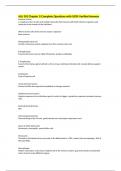
-
ALU 301 Chapter 1|Complete Questions with 100% Verified Answers Graded A+
- Exam (elaborations) • 3 pages • 2024
- Available in package deal
-
- $9.69
- + learn more
ALU 301 Chapter 1|Complete Questions with 100% Verified Answers Immune System A complex system of cells and soluble molecules that interacts with both infective organisms and molecules from outside of the individual. Where do the cells of the immune system originate? Bone marrow Pluripotential stem cell All cells of immune system originate from this common stem cell. B-lymphocytes Found in the bone marrow; fight off bacteria; produce antibodies T-lymphocytes Found in th...
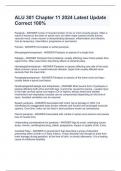
-
ALU 301 Chapter 11 2024 Latest Update Correct 100%
- Exam (elaborations) • 10 pages • 2024
- Available in package deal
-
- $12.99
- + learn more
ALU 301 Chapter 11 2024 Latest Update Correct 100%
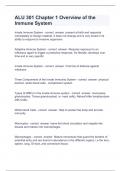
-
ALU 301 Chapter 1 Overview of the Immune System Question and answers already passed 2024
- Exam (elaborations) • 7 pages • 2024
- Available in package deal
-
- $14.49
- + learn more
ALU 301 Chapter 1 Overview of the Immune System Question and answers already passed 2024 Innate Immune System - correct answer present at birth and responds immediately to foreign material. It does not change and is very broad in its ability to respond to invasive organisms Adaptive Immune System - correct answer Requires exposure to an infectious agent to trigger a protective response. It's flexible, develops over time and is very specific Innate Immune System - correct answer Firs...
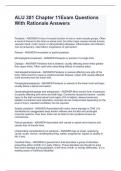
-
ALU 301 Chapter 11Exam Questions With Rationale Answers
- Exam (elaborations) • 10 pages • 2024
- Available in package deal
-
- $10.39
- + learn more
Paresis - ANSWER-Incomplete or partial paralysis. Monoplegia/monoparesis - ANSWER-Paralysis or paresis of a single limb. Diplegia - ANSWER-Paralysis that is bilateral, usually affecting lower limbs greater than upper limbs. Often used when describing effects of cerebral palsy. Hemiplegia/hemiparesis - ANSWER-Paralysis or paresis affecting one side of the body. Most common cause is cerebrovascular disease. Upper limb usually affected more severely than the lower limb. Paraplegia/parap...

-
ALU 301 Chapter 1 Complete Questions with 100% Correct Answers
- Exam (elaborations) • 3 pages • 2024
-
- $10.39
- + learn more
ALU 301 Chapter 1 Complete Questions with 100% Correct Answers Immune System A complex system of cells and soluble molecules that interacts with both infective organisms and molecules from outside of the individual. Where do the cells of the immune system originate? Bone marrow Pluripotential stem cell All cells of immune system originate from this common stem cell. B-lymphocytes Found in the bone marrow; fight off bacteria; produce antibodies T-lymphocytes Found in the...
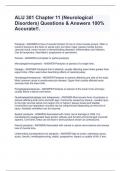
-
ALU 301 Chapter 11 (Neurological Disorders) Questions & Answers 100% Accurate!!.
- Exam (elaborations) • 10 pages • 2024
- Available in package deal
-
- $10.99
- + learn more
ALU 301 Chapter 11 (Neurological Disorders) Questions & Answers 100% Accurate!!.Paralysis - ANSWER-A loss of muscle function of one or more muscle groups. Often a result of trauma to the brain or spinal cord, but other major causes include tumors, vascular insult, motor neuron or demyelinating diseases, inflammation and infection. Can be temporary, intermittent, progressive or permanent. Paresis - ANSWER-Incomplete or partial paralysis. Monoplegia/monoparesis - ANSWER-Paralysis or paresis ...

-
ALU 301 Chapter 1 Exam Questions And Answers
- Exam (elaborations) • 2 pages • 2024
-
- $8.99
- + learn more
ALU 301 Chapter 1 Exam Questions And Answers Immune System - ANS A complex system of cells and soluble molecules that interacts with both infective organisms and molecules from outside of the individual. Where do the cells of the immune system originate? - ANS Bone marrow Pluripotent stem cell - ANS All cells of the immune system originate from this common stem cell. B-lymphocytes - ANS Found in the bone marrow; fight off bacteria; produce antibodies T-lymphocytes - AN...
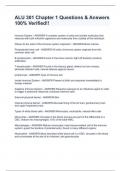
-
ALU 301 Chapter 1 Questions & Answers 100% Verified!!
- Exam (elaborations) • 2 pages • 2024
- Available in package deal
-
- $8.99
- + learn more
ALU 301 Chapter 1 Questions & Answers 100% Verified!! Immune System - ANSWER-A complex system of cells and soluble molecules that interacts with both infective organisms and molecules from outside of the individual. Where do the cells of the immune system originate? - ANSWER-Bone marrow Pluripotential stem cell - ANSWER-All cells of immune system originate from this common stem cell. B-lymphocytes - ANSWER-Found in the bone marrow; fight off bacteria; produce antibodies T-lymphocy...
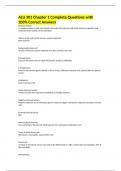
-
ALU 301 Chapter 1 Complete Questions with 100% Correct Answers
- Exam (elaborations) • 3 pages • 2024
- Available in package deal
-
- $9.50
- + learn more
ALU 301 Chapter 1 Complete Questions with 100% Correct Answers Immune System A complex system of cells and soluble molecules that interacts with both infective organisms and molecules from outside of the individual. Where do the cells of the immune system originate? Bone marrow Pluripotential stem cell All cells of immune system originate from this common stem cell. B-lymphocytes Found in the bone marrow; fight off bacteria; produce antibodies T-lymphocytes Found in the...
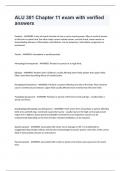
-
ALU 301 Chapter 11 exam with verified answers.
- Exam (elaborations) • 13 pages • 2024
- Available in package deal
-
- $13.99
- + learn more
ALU 301 Chapter 11 exam with verified answers.

How did he do that? By selling his study resources on Stuvia. Try it yourself! Discover all about earning on Stuvia


